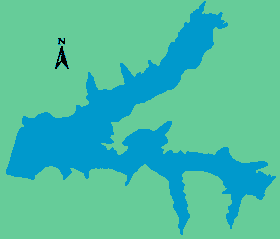Fishing
- Possession and Transport of Exotic Aquatic Species
- Licenses & Regulations
- ShareLunkers
- Fish Identification
- Fish Consumption
- Texas Freshwater Fisheries Center
Water Resources
- Texas Reservoir Levels
- US Army Corps of Engineers
- Texas Water Issues
- Golden Alga
- Aquatic Vegetation
900 CR 218
Brookeland, Texas 75931
(409) 698-9114
Dan Ashe, Biologist
Nearby State Parks
Lake Pinkston
Quick Links: Fishing Regulations | Angling Opportunities | Cover & Structure | Tips & Tactics
Lake Characteristics
Location: On Sandy Creek 10 miles west
of Center on State Highway 7
Surface area: 523 acres
Maximum depth: 45 feet
Impounded: 1976
Water Conditions
Current
Lake Level: Pinkston Water Plant (936) 598-7856
Conservation Pool Elevation: 300 ft. msl
Fluctuation: 1-5 feet
Normal Clarity: Clear
Reservoir Controlling Authority
City of Center
617 Tenaha Street
Center, TX 75935
(936) 598-2941
Aquatic Vegetation
Primarily non-native submersed (hydrilla and milfoil), but a variety of native aquatic plants are also established
Predominant Fish Species
Lake Records
Stocking History
Latest Survey Report
Lake Maps
None available
Fishing Regulations
Special bass limits and gear restrictions are in effect.
Angling Opportunities
The most popular game fish at Pinkston Reservoir is the largemouth bass. Numbers of bass are relatively high and an excellent fishery exists. The lake record is a whopping 16.9 pounds! Due to the popularity of bass fishing here, few anglers fish for crappie but a good fishery is present, especially for large crappie. Catfish have been stocked but numbers are low. Bluegill are present in high numbers and provide fast action, especially for youth or inexperienced anglers.
| Species | Poor | Fair | Good | Excellent |
|---|---|---|---|---|
| Largemouth Bass | ||||
| Catfish | ||||
| Crappie | ||||
| Sunfish |
Fishing Cover/Structure
Habitat in Pinkston Reservoir consists of submerged aquatic vegetation and standing timber. Hydrilla is the predominant plant species, although native plants (i.e., coontail, pondweed, and lily pads) are also present. Game fish are typically found around vegetation edges, points, and creek channels.
Tips & Tactics
Anglers are most successful at catching largemouth bass during
the fall, winter, and spring months. Due to cooler water temperatures, fish
are
active for longer periods of the day and are typically found in shallow water.
When fish are
active, crankbaits and spinnerbaits are usually the preferred choice. During
the hot summer, the bite usually slows and fish activity is usually concentrated
during early morning, late evening, and at night. Poppers, propeller baits,
stickbaits, and flukes are good topwater choices during low light conditions.
As the sun rises, most bass concentrate in or around vegetation edges
or seek refuge on deep creek channel ledges. During this time, plastic worms
and jigs are the preferred baits. However, Pinkston is known for its schooling
bass, especially close to the dam. Small topwaters and crankbaits are good
choices for schooling fish.
Crappie fishing is good year-round with jigs and minnows.
During the spring spawn, anglers target shallow areas around vegetation.
During
other times of the year, fish are typically concentrated in deeper
water around brush. Sunfish, especially bluegill and redear
sunfish, can be caught year-round but fishing peaks during the late
spring or summer when fish are on their spawning beds. Small jigs,
spinners, and crickets all catch sunfish.
